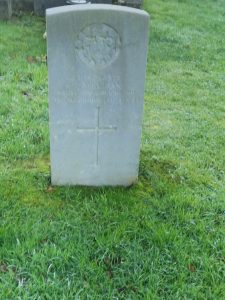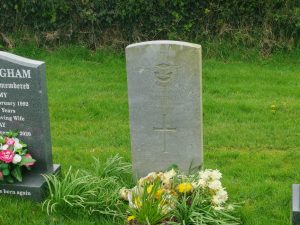Starrett, W (William)

Starrett, S (Samuel)
Private William Starrett was the fourth son of Samuel and Ellen Starrett, of 25, Duke St., Londonderry. He served with the 9th and 10th Inniskillings and was a former member of the Ulster Volunteer Force[1].
William arrived in France on the 18th of November 1915 and joined the Inniskillings. He served with both the 9th and 10th; time frame is unknown. When he was discharged from the army he was with the 9th. Either way he would have fought at the great slaughter at the Somme as the two battalions were side by side.
Later in the war, during the afternoon of the 29th of April 1917 Private William Starrett was at Kemmel village[2], Belgium. A mortar exploded close by and he was struck by shrapnel in the left hand and at the same time was also struck by a bullet in the upper lip. He was rushed to the 53rd Field Ambulance where his wounds were dressed, and his ring and little fingers were amputated.
It was also noted that he had breathing issues and his nervous system was in somewhat trouble. He spent the next 3 months in hospital and was discharged on the 27th of July 1917 and recommended to be released from service on the 1st of August. Finally, he was eventually discharged from the army on the 22nd, no longer being fit for active service.
William had suffered with chronic pleurisy[3] for another few years, possibly caused by the conditions in the trenches or the effects of poison gas attacks. At the end, he suffered for 9 days from septic pneumonia. He died with his brother Samuel, who also served with the Inniskillings, by his side on the 3rd of March 1919.
It is also possible that he may have died from the 1918 Spanish Flu pandemic.[4]
The Spanish flu is rather deceiving as it did not originate in Spain, but rather it was first openly reported on in Spain due to its neutrality in the war.
The outbreak began around January 1918 and ended at the end of 1920. There were three major outbreaks, each deadlier than the previous. Great efforts were made to suppress the news, but so many people were affected that it became pointless as the flu crept through the armies into the villages, towns, and cities of Europe. There were no vaccines to protect against this flu virus or the infections. No antiviral drugs to treat it, and no antibiotics to treat secondary bacterial infections like pneumonia. The only tools that authorities could implement was the promotion of good personal hygiene, isolation, and quarantine of the ill, along with the closures of public places.
There are several servicemen in the Counties Cemeteries who possibly died of the illness, most of whom were diagnosed with meningitis, flu, or pneumonia. It especially affected young adults.
William Starrett was awarded the 1914/15 Star, the British War and Victory Medals.
Date of Death: 03/03/1919 (Aged 23)
Service: Private, Royal Inniskilling Fusiliers, 10th, and 9th Battalions.
Service Number: 16030
Burial Location: Glendermott Church of Ireland Churchyard and New Cemetery, Sec. D. Old Ground.
[1] A Protestant Militia, based in Ireland, formed in 1912.
[2] Kemmel village is around six miles south-west of Ypres, in southern Belgium.
[3] Pleurisy is inflammation of the membrane covering the lungs. It can be very painful.
[4] Spanish Flu: 50 to 100,000,000 deaths







